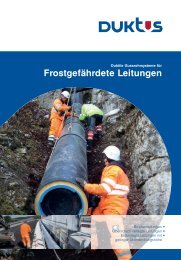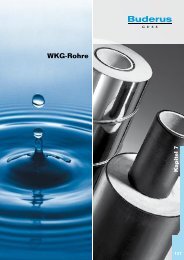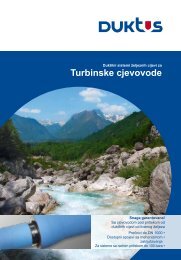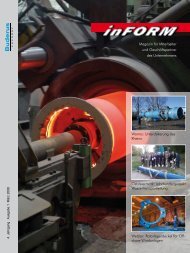Buderus Manual on Trenchless Installation of Ductile Cast ... - Duktus
Buderus Manual on Trenchless Installation of Ductile Cast ... - Duktus
Buderus Manual on Trenchless Installation of Ductile Cast ... - Duktus
You also want an ePaper? Increase the reach of your titles
YUMPU automatically turns print PDFs into web optimized ePapers that Google loves.
Both the variants <strong>of</strong> the burst lining technique, both the static <strong>on</strong>e and the dynamic<br />
<strong>on</strong>e, are in practical use at the present moment and are widely used. The DVGW has<br />
catered for this fact with its Merkblatt GW 323 [ .3] and has thus established criteria<br />
for the executi<strong>on</strong> <strong>of</strong> the techniques and also the related requirements and quality<br />
assurance measures. The burst lining technique is particularly well suited to old pipes<br />
made <strong>of</strong> brittle materials such as asbestos cement, st<strong>on</strong>eware and grey cast ir<strong>on</strong>. However,<br />
by using the static variant and special cutting heads it is also possible for steel<br />
and ductile cast ir<strong>on</strong> pipes to be burst. The new pipe which is pulled in may be <strong>of</strong> the<br />
same nominal size as the old pipe or, as dictated by the widening head which is used,<br />
<strong>of</strong> a larger size. (The widening head has to be at least the same size as the socket <strong>of</strong><br />
the new pipe).<br />
Fig. 4.2 Widening head and cast ir<strong>on</strong> pipe Fig. 4.3 Bursting head with breaker ribs<br />
General<br />
Another advantage that the burst lining <strong>of</strong> old pipes can be c<strong>on</strong>sidered to have is that,<br />
compared with replacement in open trenches, there is n<strong>on</strong>e <strong>of</strong> the tricky work <strong>of</strong> handling<br />
the old pipes that there is in open trenches and n<strong>on</strong>e <strong>of</strong> the problems with safety at<br />
work which this causes. This is true whether replacement is to the same nominal size<br />
or a larger <strong>on</strong>e. An increase in nominal size <strong>of</strong> up to two increments is possible. If the<br />
new pipeline can be smaller than the old <strong>on</strong>e, an attractive alternative is pipe relining<br />
(see secti<strong>on</strong> 7).<br />
In the field <strong>of</strong> distributi<strong>on</strong> systems, the use <strong>of</strong> the burst lining technique (or <strong>of</strong> any<br />
trenchless replacement technique) depends mainly <strong>on</strong> the number <strong>of</strong> intermediate pits<br />
required. Intermediate pits should be set up for house c<strong>on</strong>necti<strong>on</strong>s, fittings, changes <strong>of</strong><br />
directi<strong>on</strong> and cross-secti<strong>on</strong> and branch pipes. Bends up to 11° can usually be passed<br />
through. If there is too close a successi<strong>on</strong> <strong>of</strong> house c<strong>on</strong>necti<strong>on</strong>s, open trench replacement<br />
may be more ec<strong>on</strong>omical [ . ]. Equally important is the accuracy <strong>of</strong> the documentati<strong>on</strong><br />
<strong>on</strong> the existing old pipeline. If there are too many „surprises“ during the installati<strong>on</strong><br />
phase, the customer may find himself faced with a plethora <strong>of</strong> additi<strong>on</strong>al charges.<br />
7
















